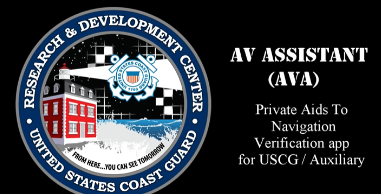March 14, 2024 —
 The Aid Verifier Assistant app, developed by the Coast Guard Auxiliary in collaboration with the Research and Development Center, automates the process of confirming that private aids to navigation are in the correct location or need to be repositioned. U.S. Coast Guard photo.
The Aid Verifier Assistant app, developed by the Coast Guard Auxiliary in collaboration with the Research and Development Center, automates the process of confirming that private aids to navigation are in the correct location or need to be repositioned. U.S. Coast Guard photo.
The Coast Guard Research and Development Center (RDC) recently was presented the Commodore Viggo C. Bertelsen Jr. and Vice Admiral John P. Currier Auxiliary Integration Award in the Applied Innovation category. The award recognizes Coast Guard units or offices that significantly leverage Auxiliary skills, experience, resources and people to improve mission performance along with achieving a totally integrated Coast Guard force.
“Auxiliary members are engaged every day in meaningful work across a spectrum of missions,” noted Michael West, regional Auxiliary commodore. “This relationship is a model for the rest of the service to follow and embrace.”
The Auxiliary is a 25,000-member volunteer organization supporting the Coast Guard across 11 missions.
While the RDC now has Auxiliary members supporting researchers on eight different projects, the relationship began in 2016 when Auxiliary personnel were deployed for shoreside and waterside test observations. These local missions evolved into requests for national support and eventually became more strategic in approach.
In addition to expanding Auxiliary support missions, the RDC has created a skills bank to pair Auxiliary members with needed resources and technology support. The move is in keeping with the Commandant’s Intent 2022 and the 2022 Coast Guard Auxiliary GAP Analysis.
The bank provides the center a much-needed project-by-project reserve and gives Auxiliary members the satisfaction of contributing to a shared purpose and putting the commandant’s vision into action.
As the Auxiliary’s value grew, it became apparent a formal bond was needed. In 2019, William Bowen, then the Auxiliary First District Southern Region commodore, coordinated with Capt. Gregory Rothrock, the center’s commanding officer at the time, and Rear Adm. Tom Allen, the Coast Guard First District commander, to create an auxiliary unit coordinator. The coordinator’s job is to establish relationships with Coast Guard units and match highly qualified Auxiliarists with specific Coast Guard projects. A formal RDC Auxiliary Unit was established in August 2020; that unit is now a virtual organization.
“This collaboration is what the RDC and the Auxiliary envisioned when the program was codified in 2015 with the creation of the RDC Auxiliary support unit by senior leadership,” said Bruce F. Buckley, auxiliarist and Coast Guard national museum ambassador at the Ledge Lighthouse Foundation. “As the Commandant's 2020 Intent states, ‘the world is changing … and so will we.’ We are all proud to be ahead of curve with this initiative.”
The members of the Auxiliary volunteer millions of hours in support of Coast Guard missions each year. Among the highlights, an auxiliarist with a doctoral degree in psychology assisted in developing cognitive enhancement tools; another auxiliarist partnered with the Coast Guard Auxiliary historian to create a history of the RDC; another auxiliarist helped to complete a novel hydroponic garden onboard Coast Guard Cutter Polar Star to grow fresh vegetables for a deployment; and an auxiliarist created a mobile app that allows for rapid reporting of private aids to navigation.
Other contributions included supporting Operation Focused Lens by assessing terrorist threats at small boat marinas and ramps on Long Island Sound and a team of five auxiliarists helping to prepare nearly 700 daily meals for the crew of Coast Guard Cutter Eagle.
For over 50 years the RDC, now commanded by Capt. Michael Chien, has been developing technology and knowledge products that have significantly enhanced and supported the Coast Guard’s ability to manage its 11 statutory missions. Continuous improvement and innovation have been key to its ongoing success and ever-broadening scope that now includes the Arctic, space, unmanned systems and climate change.

Private Aids to Navigation Verification App
For more information: Research and Development Center page and Research, Development, Test & Evaluation and Innovation Program page